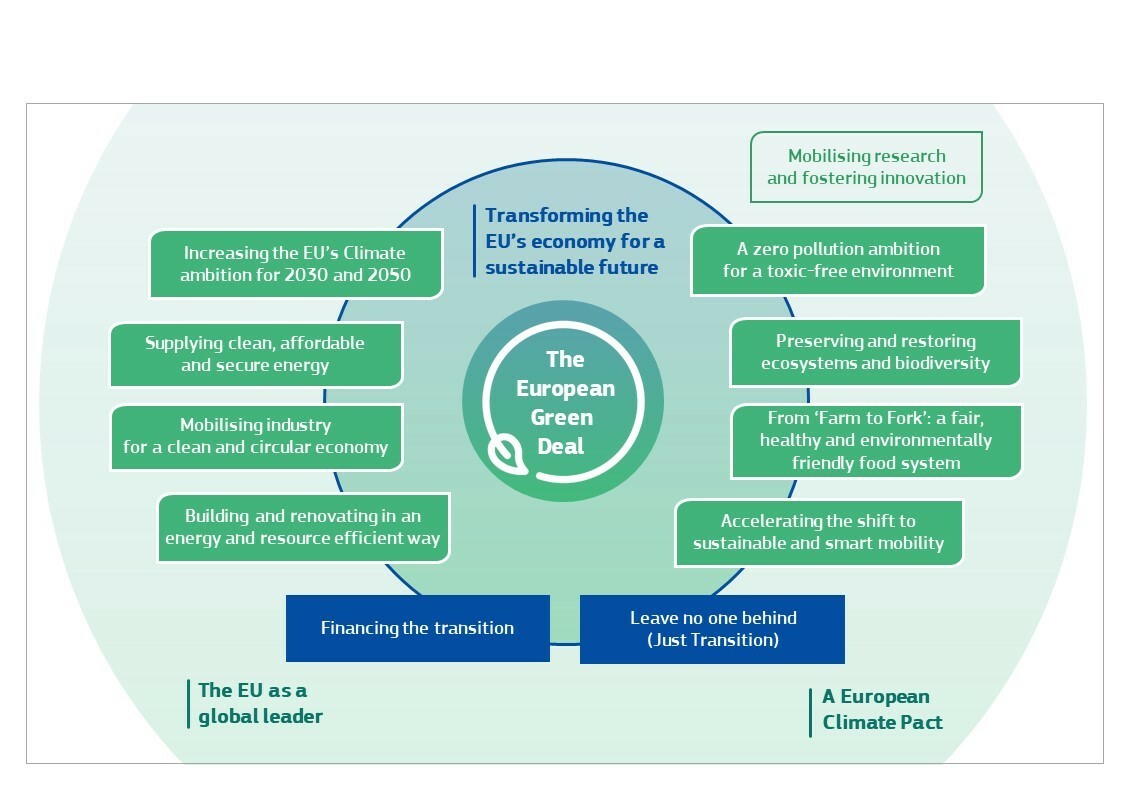The Paris Agreement, signed in 2016, aims to limit global temperature rise to below 2°C, preferably below 1.5°C, to prevent the worst impacts of climate change. The EU is building on this commitment and wants to reduce its emissions by 55% by 2030 (compared to 1990 levels) and has drawn up the Green Deal, as well as with a new set of regulations to meet its commitments. Below you can find a basic overview of what the Green Deal commits to and how the new EU Taxonomy classification system complements it.
European Green Deal
The Green Deal aims to achieve climate neutrality by 2050 and transform the EU's economy into a sustainable one. It will do this through growth that does not depend on increasing the use of natural resources. The transformation should be an opportunity for all and should be both equitable and inclusive. The European continent should become the first climate-neutral continent.
While Europe has managed to reduce its emissions in recent decades, its dependence on natural resources ranks highest in the world. This challenge will require both technological advances and a transformation of lifestyles, communities and societies.
The Green Deal will create job opportunities, particularly in innovation and investment, reduce emissions, address energy poverty, reduce external energy dependence and improve the health and well-being of all citizens.

The EU Taxonomy
The EU Taxonomy is a classification system that transforms the EU’s climate commitments into specific economic activities. It is part of the EU Action Plan on Financing Sustainable Growth and is designed to meet the objectives of the Green Deal.
The new classification system provides a transparent method to help investors, companies and politicians assess the sustainability of individual economic activities.
The system should:
- protect private investors from greenwashing,
- help companies find a path to sustainability, and
- ensure an overall easier flow of investment towards sustainability.
The EU Taxonomy introduces 6 environmental commitments:
- Climate change mitigation
- Climate change adaptation
- Sustainable use and protection of water and marine resources
- Transition to a circular economy
- Pollution prevention and control
- Protection and restoration of biodiversity and ecosystems.
The Taxonomy identifies a list of all sustainable economic activities and their assessment according to technical screening criteria to help meet these 6 commitments. In June 2021, the "Climate Delegated Act" was passed, which specifies economic activities for climate change mitigation and adaptation. The "Environmental Delegated Act", which will specify activities in the remaining 4 areas, will be introduced later.
Corporate transparency in non-financial information (Article 8)
So-called Article 8 of the Taxonomy has attracted public attention. The article specifies how companies will have to disclose information about their activities in accordance with the requirements of the Taxonomy. All non-financial entities required to report their sustainability data will also have to disclose how and to what extent the firm's economic activities are classified as environmentally sustainable. Specifically, they will have to report:
- the proportion of turnover from products or services that is linked to sustainable economic activities; and
- the proportion of capital and operating costs that are linked to sustainable economic activities.
This information will need to be supplemented by a breakdown of key KPIs based on specific economic activities and sustainability targets achieved.
Specific conditions are set for financial entities and the first wave of reporting will come into force from January 1, 2022.
The current scope of the EU Taxonomy covers environmental impacts that needed to be identified as soon as possible to build on the commitments of the Paris Agreement. Future extensions are expected to cover social and governance areas.
Implications
The EU Taxonomy provides a clear European framework for environmental sustainability commitments and will thus finally replace the imperfect system of various voluntary initiatives. Its legislative embedding is also expected to provide an "appetite" for investors to take real action in this area - by having assurance on whether and to what extent their activities are truly sustainable.


